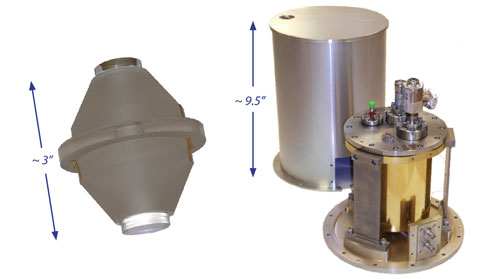Laser System on GRACE Follow-On
Laser System on GRACE Follow-On to Measure Earth’s Gravity as Never Before
March 2012 – Philip Larkin, NASA ESTO
![]()

The twin satellites of NASA’s Gravity Recovery and Climate Experiment (GRACE) mission, developed in partnership with Germany and launched in 2002, have provided a dramatic view of Earth’s variable gravity and mass distribution and spurred new insights in a variety of scientific fields. From hydrology and geophysics to ice mass estimates and global sea levels, GRACE has produced discoveries with far-reaching impacts on society.
The planned GRACE Follow-On mission, scheduled to launch as early as 2017, will demonstrate an advanced laser instrument that could improve the accuracy of inter-spacecraft ranging by tenfold or more and lead to enhanced gravity measurements. The instrument was developed at the Jet Propulsion Laboratory and Ball Aerospace with funding from the Instrument Incubator Program.
As the existing GRACE satellites orbit Earth, they encounter subtle changes, or unevenness, in gravitational pull. These gravitational variations produce slight movements in the spacecraft orbits that can be detected by careful range measurements between the satellites. GRACE uses a microwave ranging instrument, referenced to a stable quartz clock and coupled with precise GPS tracking, to measure these minute changes down to a few microns over the approximately 220 km distance separating the satellites.
GRACE Follow-On will utilize the same overall technique – carefully measuring orbit variations between twin spacecraft – but the laser approach will be much more accurate. The advantage is due largely to the shorter wavelength of the laser, compared to the microwave wavelength, referenced to a thermally isolated optical cavity, which is more stable than the quartz clock.
The laser demonstration on GRACE Follow-On will be a partnership between NASA, which will provide the laser, cavity assembly, and ranging processor, and the German Space Program, which will provide the measurement optics and steering mirror assembly along with instrument integration and testing.
For more information on emerging technologies for Earth science, visit the NASA Earth Science Technology Office website.

![]()
Top : Artist’s depiction of GRACE Follow-On.
Far Right: The prototype laser cavity, made using glass with a low coefficient of thermal expansion in order to maintain a constant distance between end mirrors.
Right: The prototype assembly and thermal enclosure for the cavity.